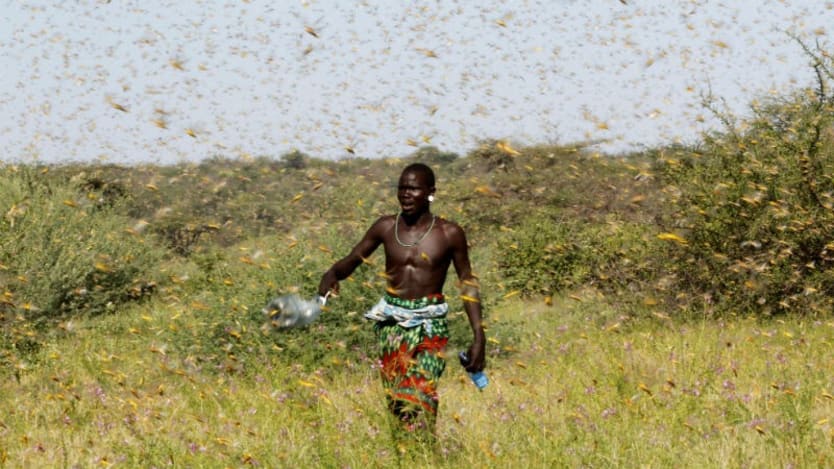
NAIROBI — Farmers across the Horn of Africa are banging pots, pans, and iron sheets, burning tires, and shooting machine guns into the sky— to scare away huge swarms of locusts from their farms and pasture lands. But this only chases the locusts from one farm to the next.
With unseasonably wet weather in the Horn of Africa, massive swarms of locusts have invaded the region — the worst infestation seen in generations.
“Droughts, floods, outbreaks, and now desert locusts. ‘When is this community going to get a break’ — is the question that I always ask myself.”
— Abdirizak Ahmed, field manager in Gode, Eastern Ethiopia’s Somali region, Save the ChildrenEthiopia and Somalia haven’t seen an outbreak this severe in 25 years, and Kenya hasn’t seen swarms of this size in 70 years. The swarms moved into Uganda and Tanzania this week, and there are concerns that South Sudan could be next.
Responders are rushing to assist these farmers in quashing the swarms by March through aerial and ground pesticide spraying campaigns before the next planting season starts. In a region that is already battling with food insecurity, the swarms — left unprevented — will only exacerbate the situation. But unless funding gaps are closed, it could turn into a humanitarian crisis, experts say.
The desert locust is considered one of the most dangerous migratory pests in the world. One locust — which can be about two to three inches long — can travel about 93 miles and a small swarm — containing 40 million locusts — can eat the same amount of food that 35,000 people can eat in one day.
One swarm in northeast Kenya was estimated to be about 1,490 miles squared with somewhere between 100 to 200 billion locusts in that single swarm, said Mark Lowcock, under-secretary-general for humanitarian affairs and emergency relief coordinator at the United Nations Office for the Coordination of Humanitarian Affairs, during a briefing on Monday.
Rapid spread
An outbreak of the locusts hit countries along the Red Sea early last year. They have since traveled to the Horn of Africa and their breeding was accelerated by recent cyclones in East Africa, creating moist conditions that are ideal for rapid locust reproduction, Bukar Tijani, assistant director-general of the agriculture and consumer protection department at Food and Agriculture Organization, told Devex.
They began to breed again at the end of January in all the three main affected countries of Somalia, Kenya, and Ethiopia, he said. They reproduce rapidly, and if not controlled, the numbers of locusts in the swarms could grow by 500 times by June. The packs are growing at “exponential levels,” Tijani said.
While vegetation on pasture land for livestock and crops have already been wiped out, the region is currently in between growing seasons. If the locust swarms are not contained by the time that farmers begin to plant, it poses a major threat to food insecurity. Thirteen million people are already grappling with severe acute food insecurity in these three countries – already recovering from recurring droughts and flooding between 2017 and 2019, Lowcock said. About 10 million of these people are located in places where there is a current desert locust outbreak.
“If this is not responded to in time, it could develop into a full-blown humanitarian crisis.”
— Abdirizak Ahmed, field manager in Gode, Eastern Ethiopia’s Somali region, Save the Children“If this locust situation is left unattended, it will worsen the situation,” Tijani said. “[Food insecurity] could easily double.”
Recent unseasonably heavy rains in the region has been linked to a weather phenomenon known as a positive Indian Ocean Dipole — which is expected to increase in occurrence as the climate changes. Rainfall between October and December was up to 400% above normal rainfall amount.
Locusts thrive in both extremely hot and wet climates, according to the U.N. Environment Programme. Under normal climatic conditions, locust swarms decrease naturally.
“Droughts, floods, outbreaks, and now desert locusts. ‘When is this community going to get a break’ — is the question that I always ask myself,” said Abdirizak Ahmed, field manager in Gode, in the Somali region of Eastern Ethiopia, for Save the Children.
Aerial spraying, funding shortfalls
Because of the massive quantities of locusts in these swarms, pesticide aerial and ground spraying is considered the only effective way to reduce their numbers.
FAO, countries, and other partners are prioritizing a rapid scale-up of spraying in the three countries. There is an urgency to do this before March and April — when the planting season begins.
“We're trying to avoid a situation where the season would come in and farmers aren't able to plant because there are locusts all over the place which will eat up their crop as soon as they are planted,” Tijani said. “There are not so many crops on the ground right now … If it’s not contained, there could be devastating consequences for hunger in this already vulnerable region.”
The role of FAO is to advise, build capacity, provide technical assistance, and also jointly with the countries, raise funds for the control of the locusts. It hosts a Locust Watch to inform countries about the status of the swarms.
FAO is also putting in place teams that can monitor and conduct surveillance.
The spraying normally is done by national governments, in partnership with the Desert Locust Control Organization for Eastern Africa — based in Addis Ababa, Ethiopia.
But countries are feeling overwhelmed.
Lazarus Ombai Amayo, Kenya’s permanent representative to the U.N., said at a press conference on Monday that his country’s efforts are “inadequate in view of the magnitude of the locusts that we are having now.”
Save the Children’s Ahmed said: “Control measures so far have not been that effective because of limited resources. The capacity to undertake the necessary monitoring and control activities is limited.”
FAO has called for $76 million to manage the crisis in the Horn of Africa, for areas such as controlling the spread, livelihood support for farmers and pastoralists impacted, and coordination efforts, but it has only mobilized $20.1 million. Half of the funds came from the United Nations Central Emergency Response Fund, as well as funding from Germany, Sweden, Switzerland, the United States, Belgium, Denmark, Saudi Arabia, the European Civil Protection and Humanitarian Aid Operations and the Africa Solidarity Trust Fund.
“The decisions and the flow of funds we’ve seen have been quite modest. Certainly not commensurate — we think — with the scale of the potential crisis we are facing,” Lowcock said.
“There is a risk of a catastrophe, perhaps we can prevent it … unless we act now, we are unlikely to do so,” he said.
There is a need to get these funds “very quickly,” Tijani said, so that countries can place orders for pesticides, protective gear and organize logistics.
“If this is not responded to in time, it could develop into a full-blown humanitarian crisis,” Ahmed said.
While the locust situation in Ethiopia, Somalia, and Kenya is the worst, there are also swarms of locusts in Djibouti, Eritrea, Iran, India, Saudi Arabia, Pakistan and Yemen.
